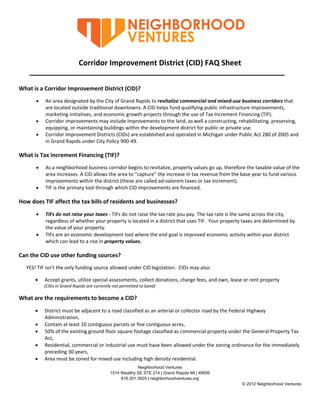
Breakout 5 Handout: CID Frequently Asked Questions
- 1. Corridor Improvement District (CID) FAQ Sheet What is a Corridor Improvement District (CID)? An area designated by the City of Grand Rapids to revitalize commercial and mixed‐use business corridors that are located outside traditional downtowns. A CID helps fund qualifying public infrastructure improvements, marketing initiatives, and economic growth projects through the use of Tax Increment Financing (TIF). Corridor improvements may include improvements to the land, as well a constructing, rehabilitating, preserving, equipping, or maintaining buildings within the development district for public or private use. Corridor Improvement Districts (CIDs) are established and operated in Michigan under Public Act 280 of 2005 and in Grand Rapids under City Policy 900‐49. What is Tax Increment Financing (TIF)? As a neighborhood business corridor begins to revitalize, property values go up, therefore the taxable value of the area increases. A CID allows the area to “capture” the increase in tax revenue from the base year to fund various improvements within the district (these are called ad‐valorem taxes or tax increment). TIF is the primary tool through which CID improvements are financed. How does TIF affect the tax bills of residents and businesses? TIFs do not raise your taxes ‐ TIFs do not raise the tax rate you pay. The tax rate is the same across the city, regardless of whether your property is located in a district that uses TIF. Your property taxes are determined by the value of your property. TIFs are an economic development tool where the end goal is improved economic activity within your district which can lead to a rise in property values. Can the CID use other funding sources? YES! TIF isn’t the only funding source allowed under CID legislation. CIDs may also: Accept grants, utilize special assessments, collect donations, charge fees, and own, lease or rent property (CIDs in Grand Rapids are currently not permitted to bond) What are the requirements to become a CID? District must be adjacent to a road classified as an arterial or collector road by the Federal Highway Administration, Contain at least 10 contiguous parcels or five contiguous acres, 50% of the existing ground floor square footage classified as commercial property under the General Property Tax Act, Residential, commercial or industrial use must have been allowed under the zoning ordinance for the immediately preceding 30 years, Area must be zoned for mixed use including high density residential. Neighborhood Ventures 1514 Wealthy SE STE 214 | Grand Rapids MI | 49506 616.301.3929 | neighborhoodventures.org © 2012 Neighborhood Ventures
- 2. What are the benefits of creating a CID? Provides a reliable, sustainable source of funding to make self‐directed district improvements, Improves the district to attract more visitors and residents from surrounding neighborhoods, Generates potential for increase sales in the district, Decreases corridor vacancy rate, Promotes economic growth, encourages investment, and corrects/prevents deterioration, Creates a public‐private partnership with the City, encourages enhanced local input, Provides economic resources for marketing, public/private infrastructure improvements, policy advocacy, parking and transportation improvements, streetscape improvements, façade improvement programs, business recruitment and retention, district lighting and security (However, funds cannot be used for general maintenance of the district) What are local examples of districts that use or have used TIFs successfully? Downtown Development Authority (DDA) Grand Rapids Division Avenue in Cutlerville, Gaines, and Byron Townships Plainfield Avenue in Plainfield Township and Grand Rapids Township City of Holland, Columbia Arts Districts DDA of Grand Haven Uptown, Madison Square and the North Quarter in the city of Grand Rapids Who governs the CID? The CID is an official City board governed by a board called a Corridor Improvement Authority (CIA), which is comprised of local property owners, business owners, and a resident of the district The Corridor Improvement Authority Board is appointed by the mayor The CIA board is allowed to hire a director to serve as chief executive officer of the authority and other personnel as it feels necessary CID Development Steps 1. Feasibility Study 2. Community Visioning/Consensus Building 3. Develop CID proposal 4. Public hearing on the proposed district with formal notice to all properties within the proposed boundaries 5. Designation of the development district including boundaries by the City Commission 6. Appointment of the CID Authority Board 7. Development of the Development/TIF Plan 8. City Commission approval of the Development/TIF Plan 9. Begin collecting TIF revenue 10. Hire Director or Manager to serve as chief executive officer of the authority 11. Develop committees and work plans and implement district improvements Neighborhood Ventures 1514 Wealthy SE STE 214 | Grand Rapids MI | 49506 616.301.3929 | neighborhoodventures.org © 2012 Neighborhood Ventures
